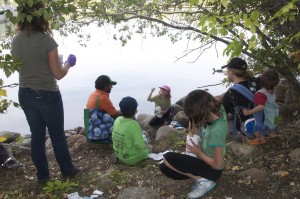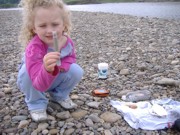May long weekend is here: begin the bush parties, litter, trucks in the river. . . I wish I could find last year's Sustainable Resource Development blog post about the perennial rotting couches. There will be liquor bans, fire bans, trail closures and check stops.
This is one of the ways we engage youth
Alberta WPACs ...Seeking Library Wizard!
Alberta's Watershed Planning and Advisory Councils seeking Library Wizard!
Alberta has shaken the blues and .... orange you glad we're in the rose of health?
Well, we've done it this time - picked ourselves up, dusted ourselves off and made it to the polls in greater numbers than in the last 22 years. Premier-designate Rachel Notley could make the difference for some of the challenges our watershed is currently facing.
WPACs of Alberta (Watershed Planning and Advisory Councils) have an important role to play: to advise government. And we've been doing it a long time. Key pieces of research like the State of the Watershed Report and the Integrated Watershed Management Plans, as well as key input into the South Saskatchewan Rgional Plan have had much work - and much hope - put into them.
It was interesting to note that both rural and urban Albertans want change and are willing to work together. Combining the orange and the rose will make a brighter future for everyone who lives, works and plays in our beautiful and unique Oldman watershed. (Suddenly Jayme Cabrera Lopez' photo of the sunrise at the top of ths blog seems serendipitously appropriate.)
We look forward to the support of both NDP and Wildrose MLAs to make things different - and to make them better.
Here's what our Executive Director, Shannon Frank, had to say about the recent election and its implications for watershed management and health .... you may need to adjust your speakers a little ... have a peek at this recent video:
You're Invited: Waterton Grizzly Film Premier May 8th
OWC April 2015 E-Newsletter
Nature's burstin' out all over!
Seeking New Board Members - Love Your Watershed




Join the Oldman Watershed Council's Board of Directors!

OWC is now holding 2 elections - one for sector organizations and one for members at large.
You must be a member by
April 30
to join the Board or vote in the election.
You don't need to be a scientist to join the Board, we also need expertise in fund development, volunteer management, communications and of course passion to get involved and help out!
We would like to invite you and/or your organization to get involved in the OWC so that your voice can be heard at the Board table. We encourage you to
(it's free), nominate someone to OWC's Board of Directors and vote on who makes up the OWC's Board of Directors.
The OWC board is comprised of 19 individuals serving two-year terms and is structured as follows:
- 4 members are appointed by their organization (1 from the Federal Government,
2 from the Provincial Government, 1 from the City of Lethbridge),
- 4 members-at-large are elected at the OWC Annual General Meeting
(bringing perspectives from the general public),
- 2 members bring First Nations perspectives, and
- 9 members are elected by their organizational sector.
The categories for the organizational sectors are:
Academia
Agricultural Producers
Commercial/Industrial Companies
Environmental Non-Government Organizations
Health
Irrigators (election held at AIPA)
Rural Municipalities (election held at Mayors & Reeves of Southwest Alberta)
Towns/Villages (election held at Mayors & Reeves of Southwest Alberta)
Wildlife Conservation Organizations
As an
individual
you can nominate yourself or someone else as a
Member at Large.
This year we have 2 vacant positions.
As an
organization
you can nominate someone from your organization to bring perspectives from your sector to the OWC Board of Directors. See the
Board of Directors job description
for more details.
Process to Participate in the
Sector
Election
(for organizations only)
Step 1:
Complete the
for your organization by
April 30, 2015
. Membership is free and is valid for one calendar year. Only members of OWC are eligible to vote for and/or serve on the Board of Directors.
Step 2 (optional):
Complete the
or
or
to nominate someone to run in the OWC sector election by May 20, 2015. This person must be willing to bring perspectives from your sector.
Step 3:
Vote in the sector election by June 5, 2015 for your sector's position on the OWC Board of Directors through an online vote. We will send you instructions by email once we have your membership form. You can still vote regardless of whether or not you submitted a nominee for this position, so long as you are an organizational member.
Process to Participate in the
Member at Large
Election
(for individuals)
Step 1:
Complete the
for yourself by
April 30, 2015
. Membership is free and is valid for one calendar year. Only members of OWC are eligible to vote for and/or serve on the Board of Directors.
Step 2 (optional):
Complete the
online or
or
to nominate someone to run in the OWC Member at Large election by May 20, 2015. This person must be willing to bring perspectives from the general public. Nominations from the floor are not accepted at OWC's AGM.
Step 3:
Voting takes place in person at the OWC's Annual General Meeting on June 23, 2015 at the Readymade Hall. Registration for this event opens soon and all members will be emailed an invitation. You can still vote regardless of whether or not you submitted a nominee for this position, so long as you are a member. Nominee biographies are included in the AGM package and nominees will be given 5 minutes to speak prior to voting.
For more information, please contact Shannon Frank, Executive Director at
or 403-382-4239.


Oldman Watershed Council
|
100, 5401 - 1st Avenue South
|
Lethbridge
|
Alberta
|
T1K 4V6
|
Canada

Kids These Days ...
I picked up the Lethbridge Herald on the way to work and began to peruse it as I sipped coffee at my desk. Would there be any local coverage of Earth Day, I wondered? Look no further than page A3, Hometown News. Tijana Martin's got a photo in there to accompany an article by Melissa Villeneuve. The photo shows Ty Marshall, 17, from Victoria Park High School. To compliment his very cool Black Sabbath T-Shirt and shades, his plastic gloves indicate serious business as he scours the coulees for garbage. So whoever said garbage-picking isn't cool?
 |
| Lethbridge Herald featuring the "Free the Children" Earth Day clean-up action. |
But there's more: in addition to participating in the Earth Day cleanup, they applied for, and were successful in procuring, $1,000 through the Telus "We Give Where We Live" program. These kids donated that money to the Lethbridge Food Bank. Environmental AND Social awareness?! Makes the Oldman just tear up at the thought of it. Seriously.
So who are the great teachers inspiring these kids? You don't have to look far - there is Mr. Sadlowski in the photo, bent over with garbage bag, right behind his student, camera slung over his shoulder, hoofing it up the coulee. Reading further, there is an additional teacher involved as co-facilitator - Karla Wright. Both teachers meet every Thursday at noon with the group, called "Free The Children".
It doesn't take the Oldman long to pick up the phone to thank the teachers and the students for their great work. A Thank You goes a long way - there is an endless supply of them, yet so few in circulation. Yes, you can quote me on that. I ask whether Mr. Sadlowski thinks the group would be interested in the OWC's Film Project. Part of the project involves reaching out to students. Donations from anyone under 18 to the Film Project are honoured with a professional photo opportunity with the OWC and a special blog posting (did you know our blog has had nearly 15,000 hits?!) Best of all, students will be invited to a free "How To Film The Watershed" seminar (to be offered in Taber, Lethbridge and Pincher Creek).
 |
| Follow #oldmangoestohollywood on Twitter for updates on the Film Project and great photos! |
Communication, after all, isn't only about "getting our message out there". It's also about supporting each other's efforts to make our watershed a better place to live, work and play - hearing each other's messages and acting on them.
Earth Day - Does It Really Matter?
We're Asking For Your Help In One Small Act
|
| |||||||||
Safe Drinking Water In Lethbridge - And Downstream!
The other day, we met with OWC's Chairman, Doug Kaupp, who is also the General Manager of Water and Wastewater for the City of Lethbridge. The City has generously sponsored the OWC Film Project as a Collaborative Partner. The OWC gets $5,000 to put toward the film-making, and the City gets three videos: one for kids, one for the public at large, and one for scientists. The Collaborative Partner gets the videos at a fraction of the commercial cost, and the Oldman gets to create invaluable educational material.
For the City's videos, we toured three main sites: the waste water treatment plant, the water treatment plant and some river locations for storm outfalls and other technology.
It's a good thing this is a story told in pictures and not in smells! ...but, here we go:

 |
This is a very complicated process.There are ten of these"sludge pools", bubbling and working away. |
 |
There is not an alien living in this tank. It is actually ultraviolet light, used to treat the water once it's past the sludge stage. It has a green tinge due to the algae. |
 |
On to the next stage! There are several buildings, each with it's own function, and all connected with massive pipes. |
 |
Jim MacDonald, left, is the Wastewater Plant Manager in Lethbridge. A lot of people are involved in making sure our water is clean and healthy for everyone downstream. |
 |
Away from all the plants and pipes and down to the Oldman River for some fresh air! We're going to see the weir (Get it?!!) |
The Beauty of Permaculture Blog
Ever wondered about your water? TEST IT!
AWQA Day, June 5th, 2015
A hands-on approach to increasing water quality awareness in Alberta
Have you ever wondered about the quality of water in your local stream or wetland?
You can have the opportunity to learn more about your local waterways by engaging in the Alberta Water Quality Awareness (AWQA) program in 2015. On June 5th we will kick-off our program for the 2015 year!
Alberta Water Quality Awareness (AWQA) aims to increase people's awareness about the health and value of water in Alberta, through hands-on water quality testing. Participants in the program are provided with a free water quality test kit.

This easy-to-use kit includes all of the materials needed to analyze four basic water quality parameters: temperature, pH, turbidity and dissolved oxygen. These basic measures of water quality have important implications for fish and wildlife habitat, outdoor recreation, and human health.
Albertans were last able to get their 'feet wet' in 2012, during Alberta's fifth AWQA event. The program was a huge success, with nearly 2000 people, from across the province, actively testing water in their communities. Families, individuals, schools, watershed groups, rural landowners, and community and youth groups all participated in the program.
Together these groups collected and tested water samples from over 200 different locations, covering all seven of the major watersheds in Alberta. These results were compiled to create a 'snapshot' of water quality in the province.
Results from past years can be viewed at www.awqa.ca

Everyone is invited to participate in AWQA 2015. Interested parties can order their free water quality test kit online at www.awqa.ca.
Kits can be ordered as a single, teacher kit package, as well as a special order for those with larger groups of students. AWQA kits will be shipped around mid-May and water quality testing can be done anytime between June 1st and August 31st. A single kit can be used ten times to test any stream, lake, river, wetland, dugout, community pond, reservoir, slough or other surface waterbody in Alberta. It is crucial to the success of this program for the data to be uploaded after collection, don't miss out on this great opportunity to get involved in the outdoors and water education.

AWQA Day is a program of the Alberta Lake Management Society in partnership with Alberta Environment and Sustainable Resource Development, and Alberta Tomorrow.AWQA Day is made possible through the generous support of our sponsor EPCOR.
For more information on Alberta Water Quality Awareness please visit www.awqa.ca.
Or contact:
info@alms.ca
(780) 415-9785
--
Time to say goodbye...
Editor's Note: Yes, it's time to say goodbye to Leta Pezderic as she moves on in her career to take up a new role. Read all about it here—and please do get in touch with her—leta@oldmanbasin.org or @LetaPez to wish her all the best of luck). Farewell and best of luck to Leta!
To celebrate Leta's time with the OWC, thank her for her contributions and provide an opportunity to say farewell and best wishes, there is an informal, come & go celebration at The Owl Acoustic Lounge (411- 3 Avenue South) on Friday, April 24 from 4-6 PM. Please join us!
Please join us in wishing Leta all the best as she leaves OWC to pursue a career with Nature Conservancy of Canada! We will miss her easy smile and caring personality. She has been a trusted representative and friendly face for the OWC over the last 6 years, responsible for building many of the strong relationships we have with partners and volunteers. Leta started with the OWC as an Executive Assistant but quickly recognized the need for a Program Coordinator to work with partners on projects and morphed into that role easily with her strength as a relationship builder. Over the years she has developed many new projects and events, always putting her all into every task. Recently she has been championing new directions for OWC to improve volunteer engagement, youth connections, and program effectiveness. Leta's commitment to quality is unwavering and has been a big part of the OWC's reputation for engaging and inspiring events.
Leta has made many friends during her time at OWC and we are fortunate to know her and look forward to a continued relationship with her in her new role. We greatly appreciate all her hard work and dedication and wish her all the best!
A message from Leta
So long, farewell, auf Wiedersehen, goodbye...
Adieu, adieu, to you and you and you!
Well, I can't believe it's been over 6 years since starting with the OWC—where has the time gone?! I think back to when I started when it was just Stephanie Palechek and myself—the OWC was up to their eyeballs in the State of the Watershed Report, the Rural Team was just pitching the idea of a Watershed Legacy Program, the Watershed Science Team was about to host its first Watershed Science Forum and the Urban Team was just launching the Prairie Urban Garden project! Now as the OWC celebrates its 10-year anniversary, I can hardly believe how far we've come! I am so proud to have been a part of it!
An opportunity has presented itself to me and I've decided to take it. I have accepted a position working with the Nature Conservancy of Canada as the Natural Area Manager for Southeast Alberta! However, it is with mixed emotions that I leave the OWC—there are so many things I will miss. Most of all though, it will be the people—the dedicated and talented staff, the passionate working Teams, and the strong, supportive Board of Directors—it is through this amazing community of people that the hard work gets accomplished!
I've been so fortunate to spend my days with so many inspiring people throughout the watershed who have taught me so much about our spectacular basin and for that I am truly grateful!
Thank you and of course, let's stay in touch! (pezderic@gmail.com)
Leta
How Naapi Helped the OWC Find a Face in time for World Water Day
OWC is hiring! - PLEASE SHARE!
|
| |||||||
Native fish – our very own aquatic ‘canaries in a coal mine’
 |  | ||














































